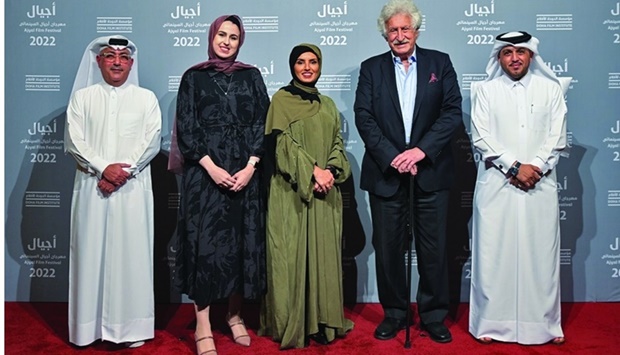Starting with a few scattered homes by the seaside in 1940, Doha today has one of the world’s most inspiring skylines. This inspiring story was the theme of the Ajyal Talks titled ‘A Skyline of Stories’ and attended by Ajyal Jurors at the Special Edition of the 10th Ajyal Film Festival.
The panel about Doha’s iconic cityscape and the future of urban environments offered more than design and architectural insights. It also served as an inspiration for the youth to approach whatever they do – be it films or arts or creative pursuits – with a clear purpose that will build a legacy.

Addressing the audience, engineer Abdullatif Mohamed al-Jasmi, director of Cultural Heritage Protection Department at Qatar Museums, manager of the Qatar Cultural Heritage Law Project and director of the Qatar-Sudanese Archaeological Project, said that cultural experiences are a bye-product that one assimilates subconsciously.
“When you travel, sit in a theatre, or walk about, you are taking in cultural experiences. That is why it is important to think about the legacy one leaves behind. If you can touch one street, one building, one monument, any one aspect of everyday life, you will leave behind an experience that would live on for generations.”
A treasure trove of stories about Doha’s architectural history was shared by Hisham Qaddumi, founder and president of the multi-disciplinary planning and design firm, The Arab Architects. The planning and technical advisor to the ruler of Qatar from 1974 to 1987, he drew on his experience of leading the planning, design and construction management of several prestigious developments, including the Doha Master Plan and iconic landmarks such as the Sheraton Doha, the National Theatre, the Doha Corniche, the University of Qatar, Hamad General Hospital, and the Diwan Amiri, among others.
Ibrahim M Jaidah, Group CEO and chief architect of the Arab Engineering Bureau, overseeing more than 1,600 projects, underlined the need to define a new purpose for heritage restoration projects. “You can restore buildings not to keep them as they are but to create a function that adds value. Every building had a story at some point of time. But soon, that story becomes a memory, which would eventually fade, as would the value of the building. We must look at the narrative of what made the building or place special and apply it to a new purpose. This reactivation will provide a new chapter in the story of the building and guarantee its place in the future,” he explained.
The session was moderated by Jumanah Abbas, an architect, writer, and curator, who works on several collaborative projects with institutes and universities.
The panel about Doha’s iconic cityscape and the future of urban environments offered more than design and architectural insights. It also served as an inspiration for the youth to approach whatever they do – be it films or arts or creative pursuits – with a clear purpose that will build a legacy.

Addressing the audience, engineer Abdullatif Mohamed al-Jasmi, director of Cultural Heritage Protection Department at Qatar Museums, manager of the Qatar Cultural Heritage Law Project and director of the Qatar-Sudanese Archaeological Project, said that cultural experiences are a bye-product that one assimilates subconsciously.
“When you travel, sit in a theatre, or walk about, you are taking in cultural experiences. That is why it is important to think about the legacy one leaves behind. If you can touch one street, one building, one monument, any one aspect of everyday life, you will leave behind an experience that would live on for generations.”
A treasure trove of stories about Doha’s architectural history was shared by Hisham Qaddumi, founder and president of the multi-disciplinary planning and design firm, The Arab Architects. The planning and technical advisor to the ruler of Qatar from 1974 to 1987, he drew on his experience of leading the planning, design and construction management of several prestigious developments, including the Doha Master Plan and iconic landmarks such as the Sheraton Doha, the National Theatre, the Doha Corniche, the University of Qatar, Hamad General Hospital, and the Diwan Amiri, among others.
Ibrahim M Jaidah, Group CEO and chief architect of the Arab Engineering Bureau, overseeing more than 1,600 projects, underlined the need to define a new purpose for heritage restoration projects. “You can restore buildings not to keep them as they are but to create a function that adds value. Every building had a story at some point of time. But soon, that story becomes a memory, which would eventually fade, as would the value of the building. We must look at the narrative of what made the building or place special and apply it to a new purpose. This reactivation will provide a new chapter in the story of the building and guarantee its place in the future,” he explained.
The session was moderated by Jumanah Abbas, an architect, writer, and curator, who works on several collaborative projects with institutes and universities.

